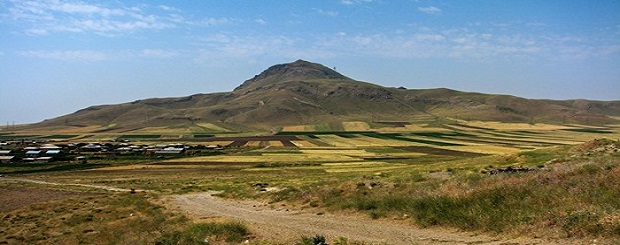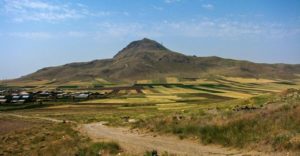
NATIONAL GEOGRAPHIC – Mount Arteni in northern Armenia – Some Arteni obsidian has already been dated at more than 1.4 million years old,
Mount Arteni in northern Armenia was the source of raw material for stone weapons transported as far as the Aegean Sea during Paleolithic times.
PHOTOGRAPH BY ELLERY FRAHM
Digs Reveal Stone-Age Weapons Industry With Staggering Output
Millions of weapons were made at Paleolithic “factory” in the Caucasus.
BY FRANK VIVIANO, NATIONAL GEOGRAPHIC
PUBLISHED APRIL 13, 2015
UNDER A CLOUDY winter sky, the eastern slope of Mount Arteni has the dull monotone of a barren wasteland. At 6,715 feet, its spare crest is dwarfed by the snow-capped 13,419-foot summit of nearby Mount Aragats, the highest point in the Republic of Armenia. The only signs of life are ragged clumps of wild grass, bent horizontal in a frigid wind from the high Caucasus.
Then the clouds suddenly break, and Arteni explodes into a dazzling mosaic of sunlit mirrors. Every square foot of ground, as far as the eye can see, is carpeted with fragments of glassy obsidian, many of them chipped and flaked into razor-sharp weapons and tools.
“We are looking at the remains of a gigantic open-air workshop,” says archaeologist Boris Gasparyan of Armenia’s National Institute of Archaeology and Ethnology. Countless blades, hand axes, scrapers, chisels, arrowheads, and spearheads produced at the mountainside “factory” circulated over a vast exchange network that long precedes the oldest recorded instances of formal trade.
Equipped with new technology that can precisely identify the origin of obsidian tools—even down to a single lava vein in a specific volcano—scientists have come to believe that Arteni was a central component in what amounts to a far-reaching Paleolithic arms industry. Its products have been traced north over the Caucasus to present-day Ukraine and west across Anatolia to the Aegean, almost 1,600 miles away.
Estimates of Arteni’s output are staggering. Active production is thought to date back to the Lower Stone Age, when the region’s first skilled artisans were early Neanderthals. Their successors mined the same materials up to 1000 B.C.E. Gasparyan and his Armenian associates, along with their American, Japanese, and European collaborators, have harvested thousands of Paleolithic tools at Arteni and other local sites.
They have barely scratched the surface, he says: “The number of obsidian implements here from different periods, from the Paleolithic to the Bronze and Iron Ages, is impossible to count. It is in the millions.”

Obsidian—a glasslike, volcanic rock—is abundant on the slopes of Mount Arteni, an extinct volcano.
PHOTOGRAPH BY ELLERY FRAHM
Technology’s Windows on the Stone Age
Scholars had long recognized the importance of the Caucasus in the saga of human history. But the violent convulsions of the 20th century—two world wars, the Russian Revolution, and the establishment of the Soviet Union, which annexed the region in the 1920s—held research to a minimum. With the Soviet collapse at the end of the 1980s, archaeology came to a complete halt. Although Armenia gained its independence in 1991, more than a decade passed before the extraordinary wealth of its resources was understood.
By 2011, says anthropologist Ellery Frahm of the University of Minnesota, it wasn’t unusual for international teams to collect 500 obsidian artifacts in Armenia in one day, numbers that quickly outran traditional methods.
Frahm met the challenge by refining two key advances in determining the origin of obsidian. The first worked on the principle that trace elements in a sample can be chemically matched to the volcano where it was produced. In effect, it bears a chemical “fingerprint.”
The conventional testing procedure was expensive and time-consuming, depending on specialized laboratories distant from archaeological sites, and requiring that artifacts be ground into a fine powder. Confronted with Armenia’s volume of artifacts, Frahm said, it was crucial “to take sourcing from the realm of ‘white coats’ in a lab to ‘muddy boots’ in the field.”
His solution was the pXRF, a portable x-ray fluorescence instrument with the dimensions and weight of a cordless drill, which can analyze an artifact’s chemical composition in ten seconds without pulverizing it. Although it had been in laboratory use for several years, the device wasn’t employed extensively in the field until 2011, when Frahm began adapting it for Gasparyan-led projects. Since then, he says, “We have analyzed more obsidian specimens than all other prior studies in Armenia combined.”
PHOTO
Fracturing along knifelike edges, obsidian was prized by Stone Age cultures for making razor-sharp weapons and tools.
PHOTOGRAPH BY JOHN CANCALOSI, NAT GEO IMAGE COLLECTION
He followed up in 2014 with a more innovative procedure, developed at Minnesota’s Institute for Rock Magnetism. Frahm and his colleagues focused on tiny black grains of magnetite, an iron oxide with magnetic properties, which are suspended in obsidian and give it its ebony color. Magnetic measurements, explains Frahm, “can reveal how these grains differ in size, shape and composition from one portion of an obsidian flow relative to another part,” he says.
The measurements fine-tune source data dramatically, yielding a far more detailed fingerprint and shedding valuable light on the toolmakers’ work habits. Did they always mine a preferred seam of obsidian, or did they move from one former lava flow to another for reasons that are not yet clear? Put simply, Frahm says, using a term borrowed from the modern arms industry, the goal was to open a window on “Neanderthal procurement strategies in Armenia.”
«Homo Erectus in the Caucasus»
Obsidian is a glasslike, volcanic rock that fractures along very sharp edges, making it ideal for Stone Age weapons. Even in modern times it has been used experimentally to manufacture surgical scalpels. But it is rarely found in Europe and Western Asia, with the notable exception of Armenia. In a land smaller than the state of Maryland, more than a dozen volcanoes hold significant obsidian deposits.
Combine that with the fact that the Caucasus was among the main land bridges of early human migration, and the wide circulation of obsidian tools from Armenia assumes enormous significance.
The Eurasian routes plied by Paleolithic obsidian are remarkably similar to those of Hellenistic and Medieval trade empires over 3,000 centuries later, including portions of the celebrated Silk Road, according to Gasparyan. But evidence is growing that those networks themselves are a recent chapter in the larger saga.
In late 2013, Georgian archaeologists announced the discovery of the earliest human fossils ever found outside of East Africa, five skulls of Homo Erectus—among our most distant ancestors—that have been dated to 1.8 million years ago. The site was just a few miles across the border from Armenia at Dmanisi, Georgia.
Some Arteni obsidian has already been dated at more than 1.4 million years old, notes Frahm. “I have little doubt,” he says, “that members of the genus Homo were using Armenian obsidians for as long as both were around.”
www.nationalgeographic.com/news/2015/04/150413-Paleolithic-obsidian-weapons-arteni-armenia-archaeology/
